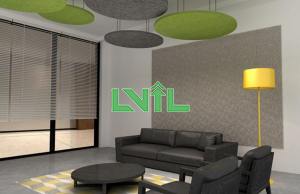How to Soundproof Walls: Simple Methods for a Quieter Space
Creating a peaceful environment in your home or office can be challenging, especially when noise from outside or adjacent rooms becomes disruptive. Fortunately, soundproofing your walls doesn’t have to be a complex or expensive process. There are simple, effective methods you can use to reduce noise and enjoy a quieter space. Here’s a guide to wall soundproofing with easy-to-implement strategies.
 https://www.lvildiy.com/
https://www.lvildiy.com/
1. Sealing Gaps and Cracks
One of the most straightforward methods to minimize noise transfer is by sealing any gaps or cracks in your walls. Sound waves can easily penetrate even the tiniest openings, making this a critical first step for noticeable noise reduction.
Unique
- Use Acoustic Caulk: Apply a high-quality acoustic caulk along the junctions where walls meet the floor, ceiling, and trim. This flexible sealant is specifically designed to block sound transmission while resisting cracking or shrinking over time.
- Seal Electrical Fixtures: Overlooked sources of noise leakage, electrical outlets and light switches can be sealed using foam gaskets or acoustic putty pads behind their covers, creating a tight barrier against airborne sound.
2. Increasing Wall Mass
The density of a wall directly impacts its sound-blocking capability—adding mass helps absorb and dampen sound vibrations.
- Heavy Curtains or Tapestries: Thick, floor-length curtains or decorative tapestries not only add aesthetic appeal but also contribute mass to walls, effectively reducing echo and softening incoming noise.
- Soundproof Paint: While less impactful than structural changes, soundproof paint contains sound-absorbing fillers that enhance a wall’s acoustic properties, providing a moderate improvement in noise reduction.
- Mass-Loaded Vinyl (MLV): A dense, flexible material, MLV can be installed behind drywall or wallpaper to significantly increase wall mass. It’s particularly effective at blocking mid- to low-frequency sounds, such as voices or traffic noise.
3. Strategic Acoustic Panel Installation
Acoustic panels are a versatile solution for improving room acoustics by absorbing sound waves and reducing reverberation. www.lvildiy.com
www.lvildiy.com
- Targeted Placement: Install panels on walls adjacent to noisy sources (e.g., shared walls with neighbors or exterior walls facing busy streets). Positioning them at ear level or near sound origins maximizes their absorption efficiency.
- Design Integration: Available in a range of colors, textures, and even custom designs, acoustic panels can complement your interior decor while enhancing sound quality—ideal for home theaters, offices, or recording spaces.
4. Utilizing Bookshelves as Sound Barriers
A full bookshelf against a noisy wall serves as a practical, non-permanent soundproofing solution, especially for renters.
Shandong Unique International Trade Co.,Ltd
- Maximize Mass: Fill shelves with books, decorative objects, or storage bins to increase density; the heavier the items, the more effective the barrier.
- Full-Wall Coverage: For optimal results, use a bookshelf that spans the entire height and width of the wall, creating a continuous surface to absorb and deflect sound.
5. Soundproofing Foam and Panels for Interior Acoustics
While not designed to block external noise entirely, soundproofing foam and panels excel at reducing echo and improving sound clarity within a room.
https://www.lvildiy.com/
- Direct Wall Application: Attach foam panels (such as open-cell acoustic foam) directly to walls in spaces where audio precision matters, like home studios or media rooms.
- Combined Solutions: For enhanced performance, pair foam panels with other methods, such as sealing gaps or adding mass, to address both sound absorption and transmission.
6. Adding a Second Drywall Layer (Advanced Method)
A more intensive but highly effective approach, installing a second layer of drywall significantly boosts a wall’s soundproofing capabilities by increasing mass and density.
Shandong Unique International Trade Co.,Ltd
- Green Glue Damping Compound: Apply a viscoelastic compound like Green Glue between the two drywall layers to absorb vibrations, minimizing sound transfer between the layers.
- Professional Installation Recommendation: While DIY-friendly, hiring a contractor ensures proper alignment and airtight sealing, critical for maximizing this method’s effectiveness.
7. Soundproof Curtains for Windows and Walls
Thicker than standard drapes, soundproof curtains are designed to reduce noise infiltration, especially through windows—common weak points for sound leakage.
Unique
- Wall-Mounted Coverage: Beyond windows, hang floor-to-ceiling soundproof curtains over entire walls facing noisy areas (e.g., a busy street), adding an extra layer of insulation and privacy.
- Multi-Layer Construction: Opt for curtains with layered fabrics or a built-in soundproofing core, which offer superior noise reduction compared to single-layer options.
8. Furniture Rearrangement for Acoustic Balance
Strategically placing furniture can act as a passive sound buffer, deflecting and absorbing sound before it reaches walls.
https://www.lvildiy.com/
- Heavy Furniture Placement: Position large items like bookshelves, wardrobes, or sectionals against noise-prone walls to add mass and disrupt sound pathways.
- Floor Coverings: Area rugs and wall-to-wall carpets absorb impact noise and reduce sound reflection, enhancing both floor and wall acoustics.
Conclusion
Soundproofing your space doesn’t require extensive construction or high costs. By combining simple techniques—such as sealing gaps, adding mass, and using acoustic panels—with strategic furniture placement, you can create a quieter, more comfortable environment. Whether dealing with urban noise, noisy neighbors, or aiming to improve room acoustics, these scalable solutions offer practical and effective ways to enhance your living or working space. From renters to homeowners, there’s a soundproofing strategy to suit every need and budget, proving that peace and quiet are within reach with thoughtful planning. Copyright Shandong Unique International Trade Co.,Ltd

